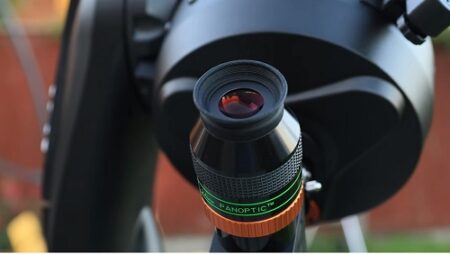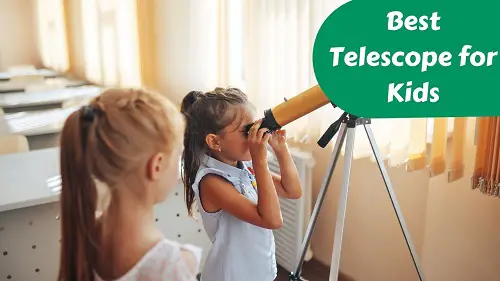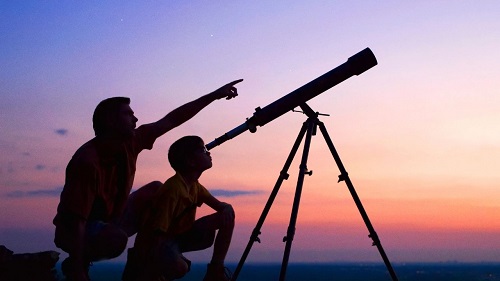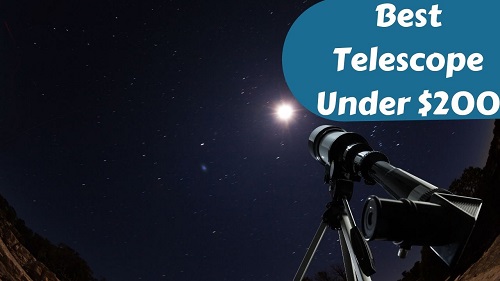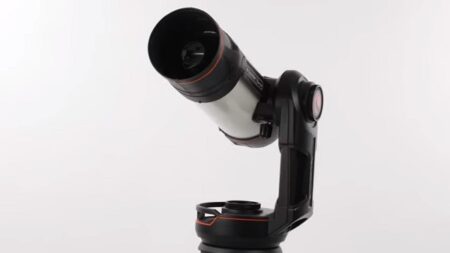
Amateur Astronomy is among the very fascinating hobbies on earth, but you most likely will need to get a telescope for yourself or maybe for a son or daughter who’s showing an interest in the marvels of the universe to get actually into it.
Many people think that the telescope is only used for stargazing. That fact is both right and wrong. On one side, telescopes are used to observe remote objects clearer for the eyes to examine. This is made possible with the use of electromagnetic radiation, which is commonly known as visible light.
Whether you’re looking to get into the exciting hobby of astronomy or you just enjoy star gazing from time to time you’re going to want to get a telescope. They are a great way to look much closer look at a wide range of different objects in the sky including the moon, planets and even the occasional asteroid or comet that passes by.
Folks all over the world appreciate studying the stars of the nighttime sky. What telescope is the most suitable choice for someone, although there are a variety of telescope designs accessible?
The inquiry of which telescope is best for a beginner is asked fairly frequently, as well as the most effective man is you! The telescope that is best for you will be dependent on your astronomy targets as well as your lifestyle.Somehow, you’ll need to locate your way through the labyrinth of catalogs, advertisements, claims and counterclaims about which particular telescope is the most affordable or greatest.
You might be asking yourself questions like “What kind should it be?”, or “Just what should I consider when I read the advertisements?”. Eventually, you’ll need to lay out the cool hard cash needed to purchase what you expect will be the very best instrument.
If you’ve ever asked yourself any of these questions…
- Which telescope should I buy?
- Can I use binoculars for astronomy?
- Why are all the stars whizzing past?
- How do I know what I’m looking at up there?
- How do I read a star chart?
- Which eyepiece should I use?
- Will a filter help me see better?
- How do I align my mount?
- What are RA and DEC?
- What can I expect to see with my telescope?
- How can I take a photograph through my telescope?
- Can I use my telescope to look at the sun?
Then this site can help you. If you’re frustrated now or a bit confused, do not stress. This informative article ought to help answer a lot of the questions you might have about buying a telescope along with clearing up a few of the puzzles about astronomical telescopes in general.
| Product Name | Magnification | Lens | Field OF View | Price |
|---|---|---|---|---|
| MaxUSee Refractor Telescope | 16X to 200X | 70mm | 7.2 Degree | Check Now |
| Celestron 127EQ | 50x | 127mm | 0.8 Degree | Check Now |
| Gskyer Telescope | 14x | 60mm | 2.40 Degree | Check Now |
| Celestron 21061 | 165x | 70mm | 1.1 Degree | Check Now |
| Celestron 114LCM | 60x | 114mm | 1.46 Degree | Check Now |
| Celestron 31042 | 50x | 114mm | 0.9 Degree | Check Price |
| Orion 09798 | 228x | 4.5 Inch | 52 Degrees | Check Price |
| Celestron NexStar 6 SE | 60x | 150 mm | 0.73 Degree | Check Price |
| Celestron 21037 | 35x | 70mm | 1.01 Degree | Check Price |
| Emarth 70mm Refracter Telescope | 20x | 360mm | 2.5 Degree | Check Price |
Top 6 Telescope Reviews
The telescope market is confusing, to say the least, so don’t panic when you see thousands of different products on the market, I am a keen amateur astronomer, and have given you my top recommendations at different price ranges.
When you take your first step towards buying a telescope you’ll likely be overwhelmed at the number of different options available to you. You can find one at virtually any price range, from the low $100’s to tens of thousands of dollars, so it is important to know which ones to choose.
I have only reviewed the best telescopes, it’s not my style to review a telescope and then say that it’s a bad product, so whichever one you see on these pages will be a good purchase.
#1 Best Budget: Celestron 127EQ PowerSeeker Reflector Telescope
The Celestron 127EQ Powerseeker is a Newtonian reflector type telescope that uses an age old approach to magnification using mirrors rather than lenses. It is intended for aspiring astronomers. It really is a simple and economical introduction to the fire of sky viewing. It features a large aperture and provides a sighting eyepiece to track movements before zooming in with a high resolution of 1.1arc per second.
It is not meant for professional astronomers or ardent hobbyists but actually targeted towards beginners or for folks who want to dabble a little in far off celestial objects.
Anyone looking for an inexpensive but competent Newtonian reflector telescope should not be unhappy with the Celestron 127eq Powerseeker. Read the Full Review
#2 Celestron 21061 AstroMaster 70AZ Refractor Telescope
Trying to find a good telescope for newcomers? The Celestron Astromaster 70az might be the choice that is right and I will let you know why!
The Celestron astromaster 70az is quite a big scope with a long tube. And to view items right overhead you need to get very low to see through the viewfinder. This telescope is designed for first-time buyers.
In reality it is a fascinating apparatus for all the people who would like to approach the astrology world. Read the Full Review
#3 Celestron 31042 AstroMaster 114 EQ Reflector Telescope
The Celestron AstroMaster 114EQ joins ease and affordability, power and operation, into one telescope. Economical telescope, in addition to being and simple to set up and use, it makes an excellent option for starting star gazers.
At exactly the same time, its optical abilities gives audiences pictures of the deep sky objects and empower even seasoned star gazers to love finding their preferred celestial objects all over.
Along with its ease, the operation of the AstroMaster sets it apart from other telescopes in the exact same budget. The scope comes. The 20mm eyepiece supplies 50x magnification, while the 10mm has an effective focusing tool with 100x magnification.
The Celestron AstroMaster 114EQ offers an attractive mix of operation and affordability. The cost is competitive with other entry level telescopes but this telescope price is not best telescope under 50.
Nevertheless, strength and the variety of the degree of detail which the AstroMaster can supply, the quality of the telescope, as well as the accessible magnification makes it appealing to seasoned stargazers.
Consequently, the AstroMaster is an excellent option for everyone who needs a telescope they are able to use to further a stargazing avocation they’ve already started to develop or who would like to delve into the nighttime skies for the very first time.
#4. Best Premium Telescope: Celestron NexStar 6 SE Catadioptric Telescope
Whether you are a veteran astronomer searching for an extremely easy way to enjoy the nighttime sky and searching for a mobile scope with advanced attributes, or just starting your astronomy experience, a NexStar SE will help you take a closer look.
The Celestron NexStar 6 SE has all the exact same attributes as Celestron’s most innovative computerized GoTo telescopes.
It will not really matter if you’re a bit of an old hand or you are merely getting started out with this astonishing and highly informative! Avocation youwill find this telescope has something to offer you.
#5 Best Professional Telescope: Orion 09798 StarBlast 4.5 Equatorial Reflector Telescope
If you’d like to go a step up farther from the fundamental mobile telescope, the highly recommended Orion 09798 StarBlast 4.5 Equatorial Reflector Telescope will do the job just right.
A general purpose telescope for beginner astronomers and even for family viewing pleasure, this telescope is packed with accessories and all the qualities you will ever need to get a night of deep-sky viewing of the moon as well as the planets. Tripod and the mount let you monitor objects that are moving throughout the sky – which is a plus for anyone who would like to see things other than planets and the moon.
The Orion 09798 StarBlast 4.5 Equatorial Reflector Telescope is made for beginners but you’d have to have some prior knowledge of how telescopes work. It offers great optics of pictures that are crisp and clear – something that most beginner telescopes take time to supply.
#6 Best Celestron Telescope: Celestron 21037 PowerSeeker 70EQ
The Celestron PowerSeeker 70EQ Telescope 21037 is a fantastic way to open up the wonders of the Universe to the aspiring astronomer!
It is intended to give the first-time buyer the best mixture of attributes, value, quality and power. Offering extraordinary value, Celestron PowerSeeker Telescopes feature portable yet powerful designs with ample optical performance to excite any newcomer to the entire world.
Amateur astronomy is a terrific family avocation that can be appreciated year round, and Celestron’s PowerSeekers are the ideal option for families looking for a high quality and affordable telescope which will provide many hours of enjoyment for kids and grownups alike.
How To Choose
Most people buy the wrong kind of telescopes the first time. As a rule, the buyer must figure out his purpose first before buying a telescope. There are only two purposes which the buyer can choose from: astronomical or terrestrial.
Terrestrial telescopes are great at providing coverage of land and its surroundings. For this purpose, it is recommended to get a pair of binoculars that can help spot movement at a quick glance. Some examples of great binocular telescopes include Predator Xtreme and the Olympus Magellan.
Astronomical telescopes vary from purpose, aperture, resolution, and size. For example, most bulky telescopes often have greater apertures allowing the viewer to see more vivid details. These types are great for astrologers, but not much for beginners as these telescopes are bigger and more expensive.
However, general purpose astronomical telescopes such as the 4.5” Newtonian or the 3” Refractor are more compact and travel-friendly. These telescopes are also cheaper but can still provide quality images.
Your telescope great to learn about the many options available to you, before buying it. I created this website to assist you in making an informed decision for your investment. However, there are a few variables that will influence your choice”
Budget
Your budget is a big deciding factor by which telescope you are going to purchase. One of the very most used telescopes among amateurs is the 6 inch Newtonian. It offers good light grip and enables a wide variety of powers in a reasonably acceptable cost ($400 bare bones to $800 for one fully equipped mounted and clock driven). These telescopes can be house constructed for under $300 and hold their resale value nicely.
Large altazimuthly mounted short focus Newtonians commonly known as “Dobsonians” are additionally affordable with many 8 inch models selling for as low as $500. Their short f ratio means they need to use eyepieces that are somewhat more expensive. Additionally, many don’t come with finders.
To get a youthful student or a beginner who is not certain of his or her interest in astronomy or who does not want to spend much cash, we advocate a short focal length (700mm or so) 2.4 inch (60mm) refractor on a good sturdy altazimuth mount. Also, binoculars are an excellent choice for stargazing also in terms of other more down-to-earth uses.
For the older child or for someone interested in astronomy as a part-time hobby, the 4.5 inch reflecting telescope is an excellent option (from f/4 for wide angle views to f/10 for higher power lunar and planetary viewing). For the individual who has a serious interest in astronomy who would like to start seeing the sights immediately, we recommend a 6 inch “Dobsonian” Newtonian reflector on an altazimuth mount.
Which Type?
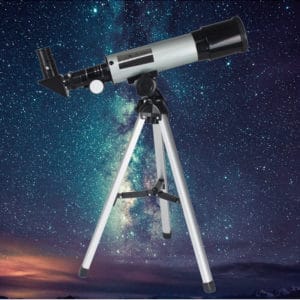
If you are totally new to star gazing, and looking to buy your first telescope, I’ll cover a couple of the basics so that you have some idea of what type to go for, and what you can expect to see with each telescope.
Refractor telescopes are the traditional looking long tube, where you look in one end, and point the telescope at what you wish to see. They are a great choice for starters, can be surprisingly powerful and can deliver some great images.
Reflector telescopes tend to be shorter and fatter, light comes in at the open end, is bounced off two mirrors, and into an eyepiece on the side of the telescope body. High-end telescopes are usually reflectors, but you can get some very cheap ones, my first telescope was a reflector, and it gave great results, for not much money.
The most affordable kinds of telescopes (small refractors and Newtonian reflectors) both have many benefits and disadvantages. The Refractor is most likely the first type so we are going to deal with it first, most folks fall upon. Because different colors of light are bent differently, a refracting telescope must utilize a particular compound chief lens which consists of at least two lenses of glass kind and different shape to correct for this unequal bending (known as Chromatic Aberration).
Additionally, all of the glass surfaces should be coated with a thin layer of substance which reduces unwanted reflections and improves contrast.
The primary lens is mounted firmly at the front of the telescope tube, and the tube is closed, keeping dust or air currents outside when the eyepiece is set up. Refractors require little upkeep, although they have to be managed with care to stop damaging or scratching the fragile coatings on all the glass surfaces. They supply good high-contrast pictures, and so are pretty popular with those who find the moon and the planets alone.
Magnification
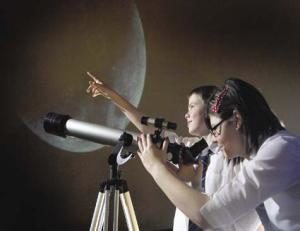
One surprising thing I found out when looking for my next telescope, was that you do not necessarily want go for the highest magnification possible. This is because unless you are going for a high end telescope, you will find that the higher the magnification, the dimmer the image becomes.
You may also find the images wobble about at higher magnifications, and this is due to movement of the air in the atmosphere. (Tip- for this reason star gazing is easier on cold nights when there is less heat disturbing the air.)
If you get a telescope with 32x magnification, you will still be able to see many objects in reasonable detail, such as the bands of cloud on Jupiter, but if possible, go for 50x magnification, which is enough to give you more detail, but not so much that the images start to dim.
If you can afford it, you will find a computer controlled telescope invaluable. These have handsets and databases that allow you to type in a set of co-ordinates and the telescope will move to the correct position to view what you want.
Without computer control, you will find yourself spending a lot of time trying to get object perfectly lined up in the eyepiece, and you will have to keep constantly moving the telescope to keep the object in view as its’ orbit and the spin of the earth makes distant stars and planets move surprisingly quickly around the sky. That’s not to say computer control is essential, but it’s certainly the best up-grade you will make.
Aperture – What will I be able to find out?
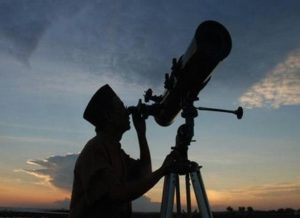
The aperture, or diameter, of a telescope relates to what you will be able to find out and just how much detail will be observable. Essentially, the bigger the aperture, the more you’ll see.
Functionality is probably the most important aspect when selecting a telescope. Being aware of what you could expect to see through the telescope will help determine which device is right for you. A telescope’s aperture, or diameter, governs how much light the telescope can gather. A larger aperture telescope is going to be able to gather more light than the usual smaller diameter device, and thus will have a way to reveal you much more detail on them and a bigger variety of night sky items. Additionally, a telescope using a larger aperture may be pushed to a higher screening magnification when compared with a smaller diameter scope.
Telescopes measuring 60-80mm (2 – 3 inches) in aperture will provide some of the brighter cloudy nebulas and star clusters, bright planets like Saturn and Jupiter, and pleasant views of the Moon.
A telescope having an aperture of 90-130mm (3.5-5 inches) will show a substantial increase in detail on the same subjects, and let you see more dim things in the sky, like galaxies, some of the more faint nebulas and star clusters.
Telescopes with apertures of 150mm (6 inches) and above are capable of providing really bright and aggressively comprehensive views of most deep space objects and solar system objects like overcast nebulas, dazzling star clusters, and distant galaxies.
Size and portability
The very best telescope is the one you will use most frequently. Little enjoyment will be brought by a tremendous, optically amazing extent if it’s consistently stuck in a wardrobe!
An old saying in amateur astronomy is “the best telescope is one that’s used frequently.” Like many expressions, it includes plenty of truth to it. A telescope’s relative as well as size portability can have an important effect on how often you use it.
While a bigger telescope will normally allow you to see more, you might not need a particularly large telescope if its size will prohibit you from using it regularly. Our guidance is to pay close focus on weight as well as the size of the telescopes you try and anticipate how much effort each one will take to create and use, and consider.
Maintaining Telescopes
Most refractors need little maintenance because its tubes are mostly sealed to protect the lenses. However, reflectors need all the maintenance efforts it can get. Its design includes an open tube which needs to be regularly cleaned since dust settles inside. This can affect the image clarity and magnification if improper care of the telescope is exercised.
To clean the insides of a reflector, the owner must take the telescope apart. This can be done by a professional so the accidental breakage of mirrors can be avoided in the process.
The Bottom Line
Astronomy is a fantastic hobby, I remember being given my first small telescope one Christmas, and while the rest of the family were sleeping off the turkey, I was out in the cold getting my first views of the moons of Jupiter, tiny points of light that were invisible to the naked eye.
That had me hooked, but straight away I saw what a huge range of telescopes were on offer, and had no idea what was suitable for my budget, what things were essential or just nice options, or even the difference between refractor, and reflector telescopes.
Telescopes for amateur astronomy have never been much more powerful and more affordable than they are now. Amateur astronomers can nevertheless find comets and supernovae, and as a backyard astronomer, you can check out identical stars and planets the professionals find as well as gauge the size of asteroids.
Of whatever may be the best beginner telescope, the issue depends on your goals and you in the avocation. We recommend you take advantage of information and resources such as our website and index to help you make the most suitable choice for you as well as your loved ones.
If you are in a similar situation, then hopefully, things will be much clearer after you read this.I will be adding as many reviews, articles, guides, and advice as I can in future, but at the moment, you can visit Amazon for full reviews of my recommended telescopes, until I get time to add them here.

I’m Ali. BestTelescopeReview.com is my little place on the web to express what I’ve learned first-hand, specially about the telescope part. I am writing these articles to share my love for astronomy with you.

![Best Telescope Reviews for 2024 [Everything You Need To Know]](https://besttelescopereview.com/wp-content/uploads/2019/05/Best-Telescope-Reviews.jpg)
